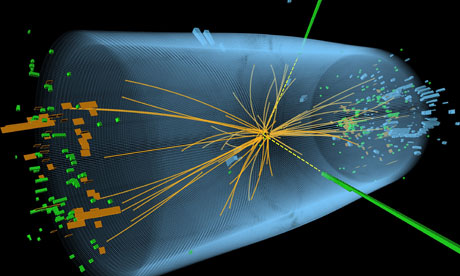With the discovery of the Higgs boson at CERN (the European Organization for Nuclear Research, in French) earlier this week, it’s about time you learned a little bit more about particle physics, isn’t it? Before you go celebrating with a bottle of champagne, in the style of physicists currently celebrating all over the globe, here’s a little crash course on the Higgs boson and some of the physics they didn’t get into during your introductory college course.
What particle physicists are tentatively calling the Higgs boson was discovered at the Large Hadron Collider, a 16.5-mile tunnel over 100 meters beneath the French-Swiss border. Finding the missing Higgs boson was one of the purposes for which 111 countries collaborated to build the Large Hadron Collider. Two different teams of researchers, together comprising a total of about 5,000 people, analyzed over 800 trillion proton-proton collisions done over two years; last winter brought the first hints that a new particle that could be the Higgs boson was on the brink of being found.

Large Hadron Collider
The Large Hadron Collider fires protons at one another at nearly the speed of light. These collisions create flashes of energy, which include electrons, quarks, light, and, occasionally, what researchers now believe is the Higgs boson. Data from the collisions is collected inside one of several detectors, each run by a different team, some with thousands of researchers. The difficulty in locating the Higgs boson comes, in part, from its rapid decay into other particles, which may, in turn, decay into even different particles.
The discovery of the Higgs boson is at a preliminary stage. While CERN researchers willingly admit that a new particle has been discovered, they only tentatively claim this particle is the elusive Higgs boson, which theoretical physicist Peter Higgs first proposed in 1964.

Peter Higgs
Some physicists only call the particle “Higgs-like,” but as of July 4, evidence that the particle is really the Higgs boson was strong enough for Fabiola Gianotti (leader at the LHC particle detector ATLAS and proof that women kick ass at science) and Joe Incandela (spokesperson for the CMS detector research team) to announce the discovery and present convincing evidence of the Higgs boson at a special seminar at CERN.
There are many types of elementary particles according to the Standard Model of particle physics, including two other bosons (the W and Z gauge bosons). The Higgs boson is unique in that it has no intrinsic spin, and in the Standard Model, the Higgs boson is the particle that explains why other elementary particles have mass. Every type of particle in the Standard Model is associated with waves in a field, such as, photons, which are associated with waves in the electromagnetic field. The Higgs boson is the particle that makes up the Higgs field.
The Higgs field introduces resistance to particles, which would otherwise zoom around at the speed of light. This field interacts with different particles to different extents, which in turn makes some particles heavier than others. So, this is a cornerstone in the theory behind how particles gain mass – it is the resistance they encounter as they move through the Higgs field. Only the photon encounters no resistance in the Higgs field, leaving it with no mass.
While many physicists have believed in the Higgs boson for nearly 50 years without seeing it, the discovery of the elementary particle is a welcome vindication to Peter Higgs and his fellow physicists who coined the theory in 1964. The particle is a key piece of the Standard Model and has been hailed as one of the missing cornerstones of particle physics. It also means that the vacuum of space isn’t actually empty – the Higgs field is present there too.
Stephen Hawking purportedly placed a bet with another physicist that the Higgs boson would never be discovered, and has, as a result, lost $100.


Comments are closed.